February 2019 LIP of the Month
Hekpoort Formation, South Africa, ca. 2.223 Ma
Wladyslaw Altermann,
Exxaro Chair, Department of Geology, University of Pretoria, RSA.
This is based on the following:
Humbert et al., 2018, Petrology, physical volcanology and geochemistry of a Paleoproterozoic large igneous province: The Hekpoort Formation in the southern Transvaal sub-basin (Kaapvaal craton) Precambrian Research, 315, 232–256;
And
Humbert et al., 2019, Neoarchaean to Early Palaeoproterozoic Within-Plate Volcanism of the Kaapvaal Craton: Comparing the Ventersdorp Supergroup and the Ongeluk and Hekpoort Formations (Transvaal Supergroup), In Kröner, A. and Hofmann, A. (eds): The Archaean Geology of the Kaapvaal Craton, Southern Africa, Publisher: Springer Nature Switzerland AG, March 2019. 277-302. DOI: 10.1007/978-3-319-78652-0_11,
The Archaean-Palaeoproterozoic Kaapvaal craton (South Africa) records several successive voluminous intra-plate magmatic events. Here we concentrate on the early Palaeoproterozoic Hekpoort Formation (Fm.) which represents an episode of widespread continental flood volcanism and localized rift-related sedimentation at about 2223 Ma in the Transvaal sub-basin, South Africa. The Hekpoort volcanism predates the emplacement of the ∼2.055 Ga LIP of the Bushveld Igneous Complex (BIC), the world’s largest layered intrusion and an endless source of chromium and Platinum Group Elements (PGEs).
Based on its areal extent of ca. 100,000 km2 and maximum thickness of up to 1100 m (Lenhardt et al., 2012), the Hekpoort Fm. can be classified as a Large Igneous Province (LIP). The Hekpoort LIP consists of a thick subaerial volcanic sequence in which volcanoclastic rocks occur mainly at the base. Localized hyaloclastites and variolitic rocks record the presence of ponded water in lacustrine and adjacent environments, while interbedded sedimentary rocks and paleoweathered flow tops suggest prolonged time-breaks in volcanic activity. The Hekpoort Fm. is the youngest of a trinity of Neoarchean to Paleoproterozoic subaerial large igneous provinces of the Kaapvaal craton, encompassing the Ventersdorp Supergroup (2.78-2.71 Ga) and the Ongeluk Fm. (2.426 Ga).
The sedimentary and tectonic setting of the Hekpoort and Ongeluk formations within the Transvaal basin and their geochemical character are so similar that both formations were long viewed as lateral equivalents of each other, but representing different subbasins. Only the dating of dykes in the Ongeluk Fm. (Gumsley et al., 2017) revealed that it is actually ca. 200 myr older than the Hekpoort Fm. Thus, the two formations do not correlate and there is a large age discrepancy between the Pretoria Group in the Transvaal subbasin (Hekpoort Fm.) and the Postmasburg Group in Griqualand West (comp. Eriksson et al., 2006). At the same time Humbert et al. (2017) showed that the paleomagnetic poles for the Ongeluk and Hekpoort formations differ from each other (the Ongeluk paleopole being characterized by Evans et al., 1997).
The age of the Hekpoort Fm. is not precisely constrained. Dates of 2236 ± 38 Ma (whole rock Pb–Pb isochron; Cornell et al., 1996) and 2224 ± 21 Ma (whole-rock Rb–Sr isochron; Burger and Coertze, 1973) result directly from the lavas. U-Pb SHRIMP dating of detrital zircons from palaeosols or interbedded sedimentary units in the formation yielded a maximum age of 2247 ± 10 Ma (Schröder et al., 2016). Sedimentary rocks directly overlying the Hekpoort Fm. contain detrital zircons of 2233 ± 15 Ma (Dorland, 2004 – U-Pb SHRIMP ages).
The Hekpoort Fm. is composed mainly of thick successive lava flows interpreted as originating from a single magma pulse (i.e., similar to ‘tabular-classic flows’, Jerram, 2002). The lava flows have thicknesses of between 8 and 60 m, and are often characterized by amygdaloidal flow tops with thicknesses between 0.5 and 1 m. Abundant amygdales are coalesced, with anastomosing geometries and are partially or completely filled with secondary minerals: mostly quartz, but also clinochlore, zeolite and calcite. The flow tops can be highly altered. These apparent weathering horizons are more common near the base of the formation, which may suggest a lower initial eruption rate. However, all outcrops have a reddish hydroxide coating due to weathering. Locally developed, several meters-thick flow top breccias were described and volcanoclastic materials occur in the formation (e.g., Button, 1973; Sharpe et al., 1983; Oberholzer, 1995; Oberholzer and Eriksson, 2000; Coetzee, 2001).
Manifold additional physical volcanology phenomena can be observed in these ancient lavas (Humbert et al., 2018b), such as:
- Shear induced outgassing or ‘second order’ lava flows
- Vesicle cylinders of amygdale concentrations in the form of oblique columns or pipes
- Pahoehoe lava or ropy lava flow tops
- Hyaloclastites
- Variolitic lava flows
- Stratified and massive lapilli tuffs and lapilli tuff breccias
- Pyroclastic breccias
- Lahars and related mass flow deposits
Like most Archean to Paleoproterozoic LIPs, the Hekpoort rocks underwent at least greenschist facies metamorphism but also episodes of metasomatism and silicification. Preserved primary magmatic minerals are clinopyroxene (pigeonite, augite and diopside), and rarely plagioclase (labradorite).
Lavas of the Hekpoort Fm. are mostly basalts, with widespread silicification responsible for increased SiO2 content. The variable whole rock Mg# (evolving from 69 to 50) and the changes in clinopyroxene composition attest to magmatic fractionation. The Hekpoort Fm. displays remarkably similar trace elements patterns to those of the 200 myr older Ongeluk Fm. in the west of the Kaapvaal Craton; such a compositional match is remarkable and unique among the Precambrian mafic magmatic units of the Kaapvaal Craton.
Similar to the mafic rocks of the Ventersdorp Supergroup (2.78-2.71 Ga) and the basalts of the Ongeluk Fm. (2.426 Ga), the Hekpoort basalts show an arc-like trace element signature, mainly represented by negative Nb-Ta anomalies (in normalized trace element patterns). The Hekpoort and Ongeluk also exhibit relatively high contents of Th and U and high Th/Nb ratios, which sharply contrast with Archean units. The Hekpoort magmas thus seem to represent a stage in a progressive differentiation series from a single parental magma with variable degrees of crustal assimilation, strongly inconsistent with their extrusion order on the craton, and which can be related to metasomatism of the subcontinental lithospheric mantle by past subduction(s). This suggests that a subduction process marked the Archean-Proterozoic boundary on the Kaapvaal craton.
The Hekpoort Fm. was described as having been largely deposited in a subaerial setting (e.g., Button, 1973; Sharpe et al., 1983; Engelbrecht, 1986; Eriksson and Twist, 1986; Oberholzer, 1995; Reczko et al., 1995) and is seen as a major continental flood basalt event on the Kaapvaal craton (e.g., Reczko et al., 1995; Cornell et al., 1996). Notable is the absence of wide-spread pillow lavas, and the presence of rare hyaloclastites and of pahoehoe flow tops with uniform amygdales layers. In a small area east of Pretoria a bedding plane with preserved syn-depositional raindrop imprints has been identified (Altermann et al., 2018), clearly evidencing subaerial deposition.
Localized ponds and lakes (Button, 1973) can explain the hyaloclastites and possible pillows at the top of the Hekpoort Fm., and the variolitic lava flows (Humbert et al., 2018a) and volcanoclastic rocks, which mostly result from phreatomagmatism. Nevertheless, lavas are preponderant in the whole Hekpoort Fm. (Button, 1973; Sharpe et al., 1983; Engelbrecht, 1986; Schreiber, 1991). The rare presence of large amount of volcanoclastic rocks in some localities (e.g., the Hekpoort River Valley, suggest that the Hekpoort magma chamber was rich in volatiles and/or that the lava encountered fluids at shallow surface (e.g., Fisher and Schmincke, 1984), thus promoting a more explosive style of volcanism and allowing the formation of varying proportions of lava flows and pyroclastic rocks.
The Hekpoort river area is in a way anomalous because it contains mainly coarse volcanoclastic deposits and mass flow deposits of lahars and coarse tuffs (Oberholzer and Eriksson, 2000; Humbert et al., 2018b). In places, the NE striking strata are oriented partly sub-vertical, with evidence for folding and faulting, but without developed schistosity. Areas with subhorizontal bedding appear to be separated by normal faults from steeply dipping blocks of regional extent. Humbert et al. (2018b), envisage therefore the development of a paleo-graben valley during the subsidence of the Kaapvaal craton, which experienced stretching perpendicular to graben shoulders (Eriksson et al., 2006). Mass flows were triggered by earthquakes, accompanied by volcanic eruptions which led to the accumulation of thick and laterally extensive fans of coarse to fine, proximal to distal volcanoclastic deposits. This extensional event was likely an underlying cause for Hekpoort magmatism. Similar processes were discussed for e.g., the Ventersdorp LIP lavas by Van der Westhuizen et al. (2006), Altermann and Lenhardt (2012) and Humbert et al. (2019).
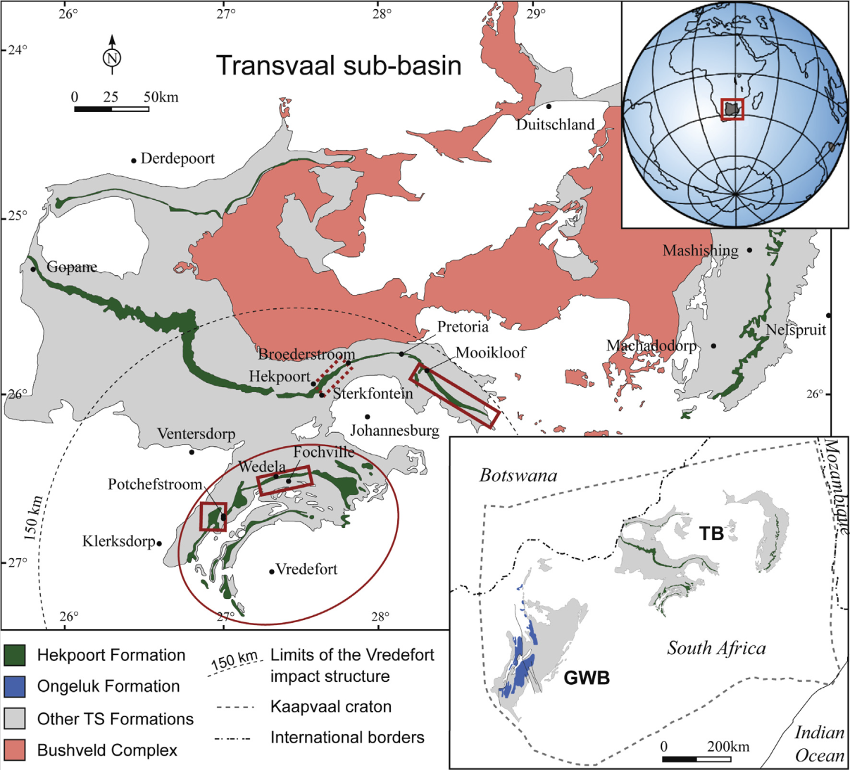
Fig. 1. Distribution of the outcrops of Hekpoort Formation in the Transvaal sub-basin with the Bushveld Complex in the centre of the Transvaal Supergroup. (TB) and the Ongeluk lava formation in the Griqualand West sub-basin (GWB); compiled from 1:250000 South African geological maps. The location of both subbasins within the Transvaal basin it is shown in the bottom right inset. The red rectangles and the red ellipse represent the studied areas; the rectangles emphasizing zones with outcrops (zones sampled: solid rectangles; the Hekpoort river valley: dashed rectangle). The dashed circle segment represents the maximum extension of the Vredefort Impact Structure. (From Humbert et al., 2018b).
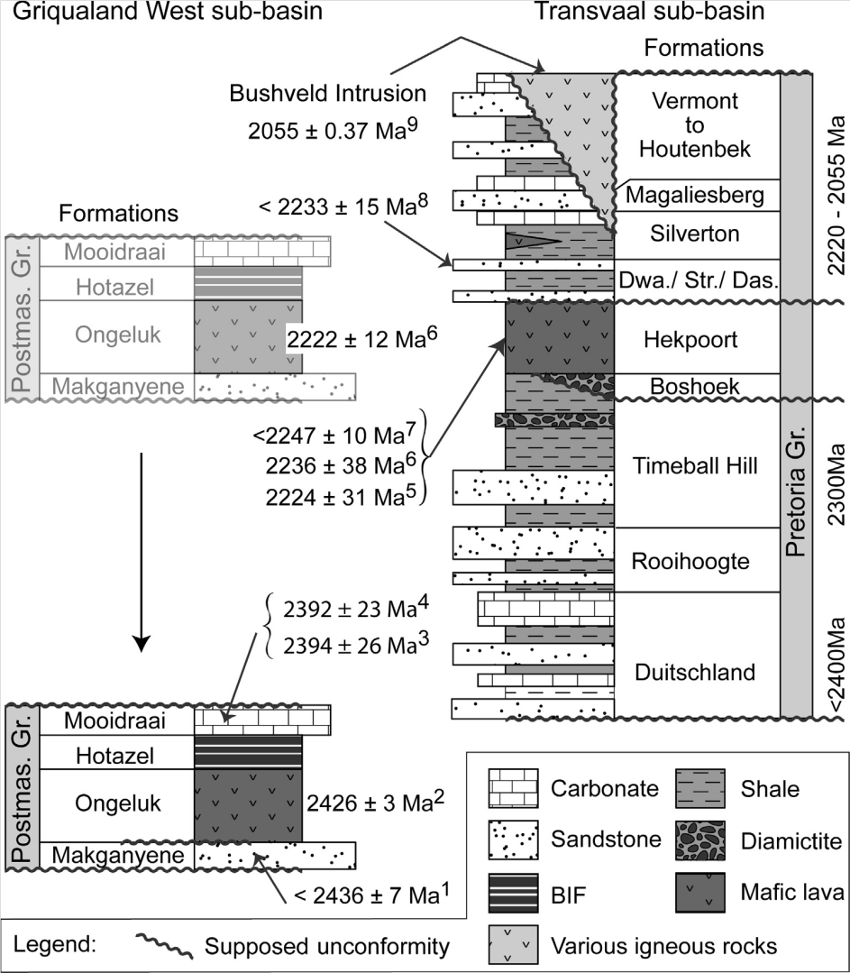
Fig. 2.
Chronostratigraphy of the Transvaal Supergroup based on Gumsley et al. (2017) and Humbert et al. (2017). The age dates are from: (1) Moore et al. (2012) – U-Pb on detrital zircon, (2) Gumsley et al. (2017) – U-Pb on baddeleyite, (3) Bau et al. (1999) – carbonate Pb–Pb isochron, (4) Fairey et al. (2013) – whole rock U-Pb isochron, (5) Burger and Coertze (1973) – whole rock Rb-Sr isochron, (6) Cornell et al. (1996) – whole rock Pb–Pb isochron, (7) Schröder et al. (2016) – U-Pb SHRIMP on detrital zircon, (8) Dorland (2004) – U-Pb SHRIMP on detrital zircon, (9) Zeh et al. (2015) – U-Pb on detrital zircon. Formations of the Pretoria Group: Das.=Daspoort; Dwa.=Dwaalheuwel; Str.=Strubenkop. (From Humbert et al., 2018b).
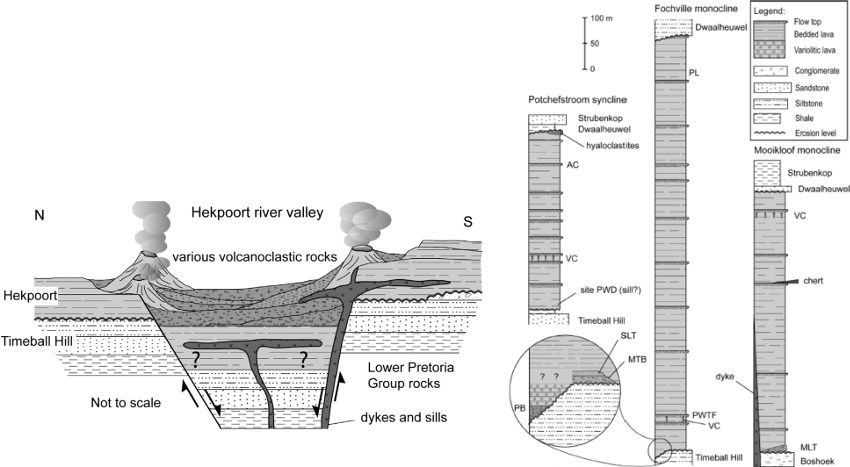
Fig. 3. N-S schematic cross-section of the Hekpoort Formation along the Hekpoort river valley and a composite vertical sections of the three main sampling zones. AC=amygdale layer rich in clinochlore: MTB=massive tuff-breccia; MLT=massive lapilli-tuff; PB=pyroclastic breccias; PL=pahoehoe lava; PWTF=paleo-weathered flow top; SLT=stratified lapilli-tuff; VC=layer rich in vesicle cylinders. See text for discussion. (From Humbert et al., 2018b).
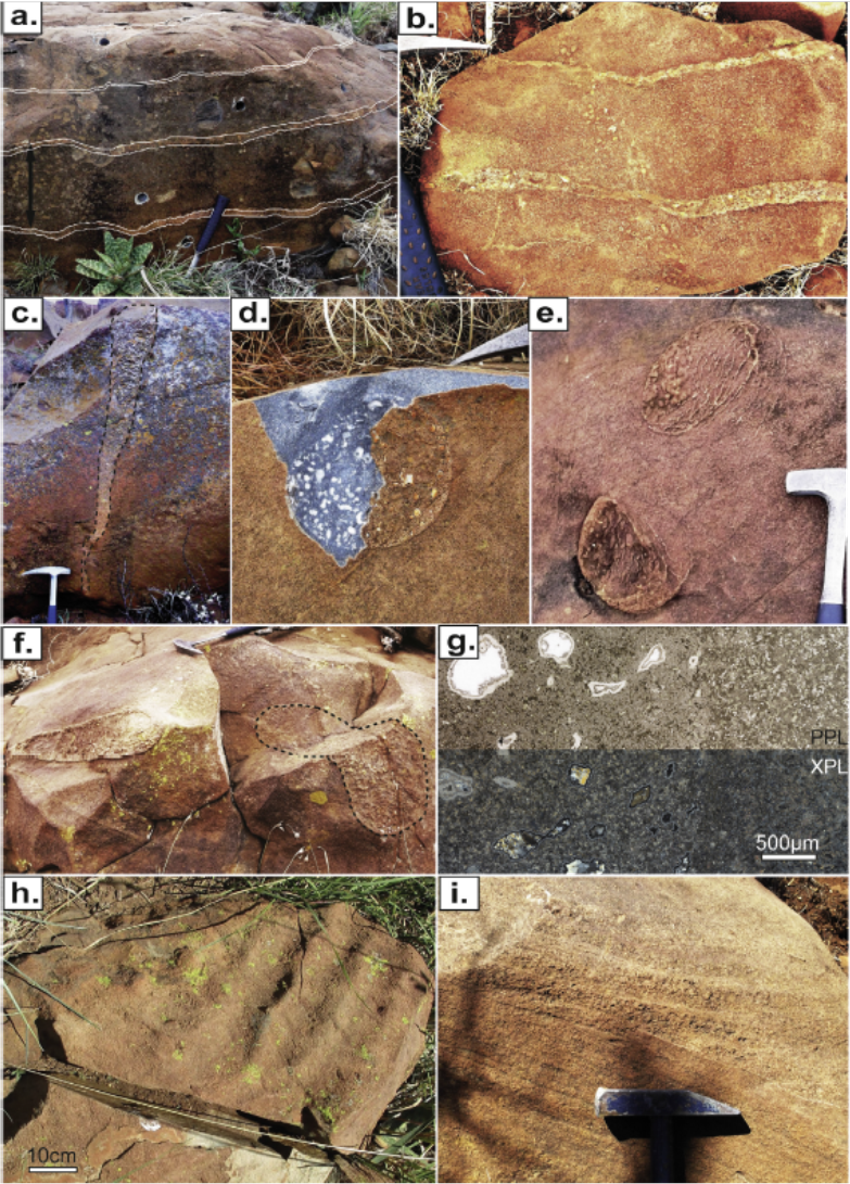
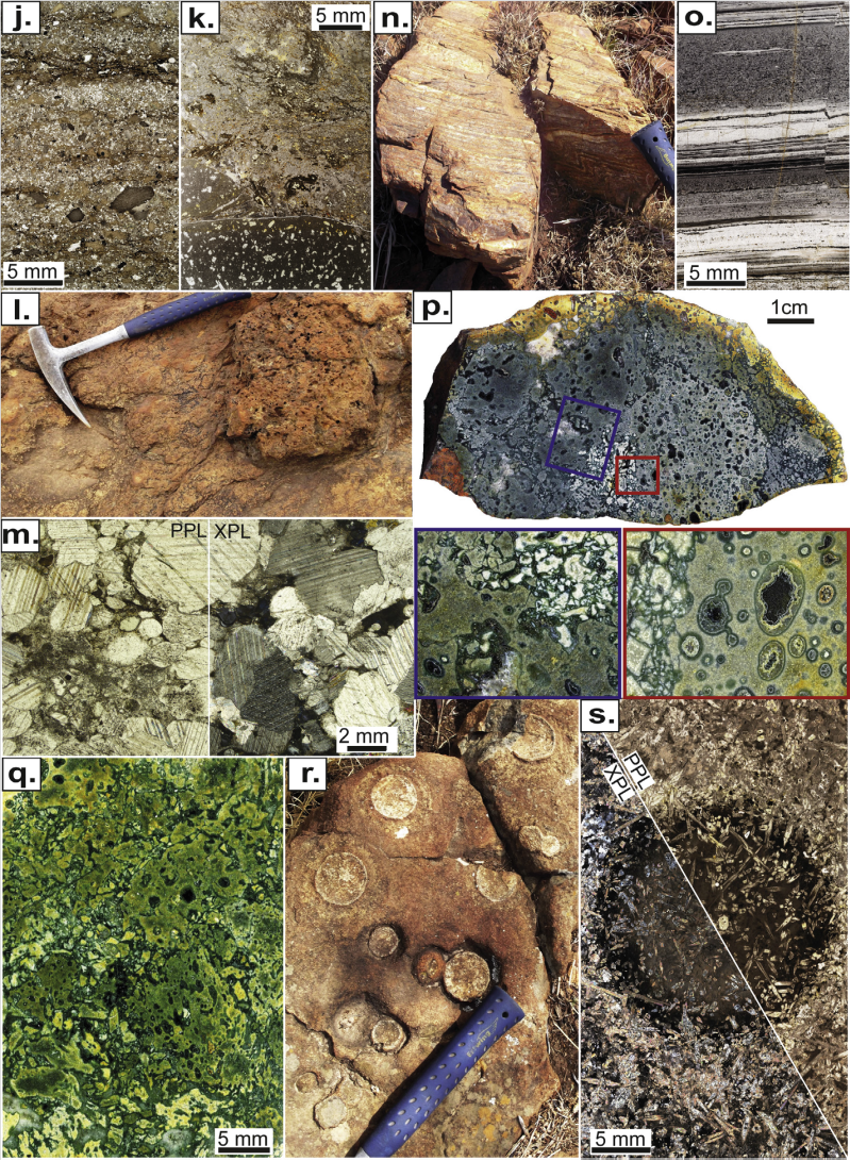
Fig. 4. (a.) and (b.) Subparallel layers showing high concentrations of amygdales that can either be ‘second order’ lava flows or related to shear-induced outgassing; a tiny oblique vesicle cylinder can be also be seen in (b.). (c.) to (g.) vesicle cylinders in subvertical (c.) and subhorizontal (d., e., f.) sections with a fresh surface in (d.) and in thin section (g) showing the contact between the cylinder (left side) and the surrounding lava (right side). Some vesicle cylinders are asymmetrical (e.) or elongated (f.), likely linked to their development while the lava flow was still mobile. (h.) example of pahoehoe lava. (i.) to (l.) volcanoclastic rocks: stratified lapilli tuff (i., j.) massive lapilli-tuff (k.), pyroclastic breccia showing a block that was a flow top (l.). Detail of limestone xenolith, showing rounded crystals of calcite in the massive lapilli-tuff (m.). (n.) and (o.) interbedded sedimentary units in the area of Mooikloof of metamorphosed fine sandstone rich in iron oxide (o.). Some kink folding can be observed in the outcrop (n.) as well as in the thin section (o.). (p.) and (q.) hyaloclastites from the Potchefstroom syncline (Fig. 4) showing vesicle-rich block surrounded by breccias; see close-up in (p.). The up to half centimeter-thick yellow rim around (p.) is linked to recent weathering. (q.) evidence of palagonitisation. (r.) variolitic lava flows showing individual variolites and partly coalescent in the center of the picture. Diffusion areas between the variolites and the groundmass can be observed (bright 1–2 cm rims around the variolites). (s.) thin section of a small variolites. The center is occupied by an orthopyroxene crystal now fully pseudomorphosed by clinochlore. (From Humbert et al., 2018b).
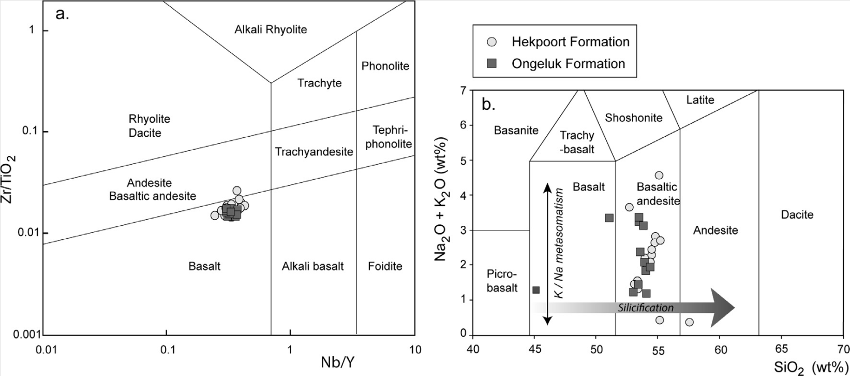
Fig. 5. (a.) Classification diagram of Winchester and Floyd (1977), modified by Pearce (1996) with the Hekpoort and Ongeluk samples. (b.) Same samples in the Total Alkali versus Silica (TAS; Cox et al., 1979). In the latter, the samples mainly plot in the range of basaltic andesite due to an increase of SiO2 related to silicification and the pronounced scatter of samples along the Y axis is the consequence of K- and Na-metasomatism. (From Humbert et al., 2018b).
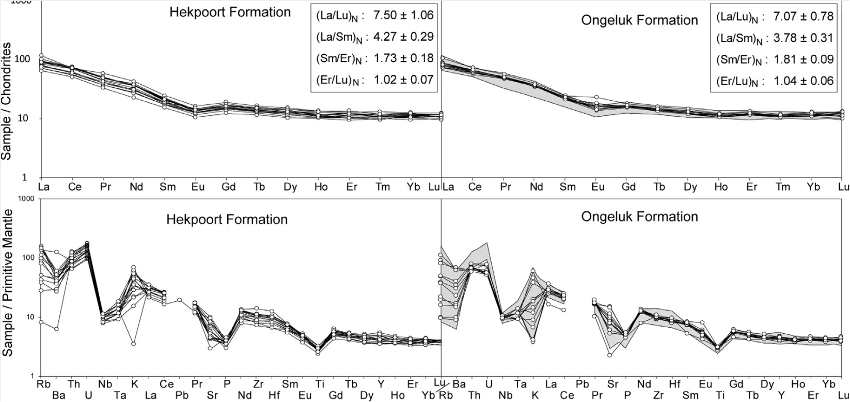
Fig. 6. REE (a, b) and multi-element diagrams (c, d) of the same samples as in Fig. 5. Samples were normalized to chondrites (REE diagram) and to primitive mantle (multi-element diagrams) respectively, after Palme and O'Neill (2014). The shaded area behind the Ongeluk samples corresponds to the Hekpoort samples on the left. (From Humbert et al., 2018b).
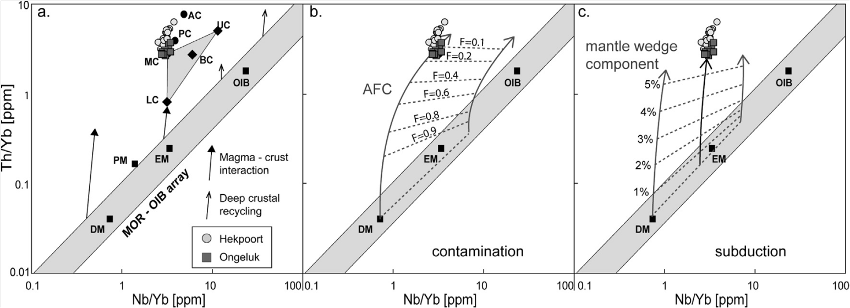
Fig. 7. (a. to c.) Th/Yb versus Nb/Yb diagrams. Subduction zones have Nb/Yb ratios similar to Depleted Mantle, but higher Th/Yb ratios. Enriched mantle sources have higher Nb/Yb as well as Th/Yb ratios. The examples of crustal input model by contamination (b.) and subduction zone (SZ) component (c.) are taken from Pearce (2008). In (b.), the AFC model is characterized by a rate of assimilation relative to the rate of crystallization r=0.3; F=proportion of mass of magma remaining relatively to its initial mass. The SZC model in (c.) is based on (Th/Nb) SZ=5 and (ThSZ/Th DM-magma)=100; %=% SZ component in wedge. Note that the assimilation–fractional crystallization (AFC) and subduction zone component (SZC) models in Fig. 12(b, c) are from Pearce (2008) and purely indicative. DM=Depleted Mantle, PM=Primordial Mantle, EM=Enriched mantle, OIB=Oceanic Island Basalt source (Sun and McDonough, 1989), LC=Lower Crust, MC=Middle Crust, UC=Upper Crust, BC=Bulk Crust, PC=Phanerozoic Crust, AC=Archean Crust (Rudnick and Fountain, 1995). (From Humbert et al., 2018b).
Click to open/close ReferencesReferences
Altermann, W., Lenhardt, N., 2012. The volcano-sedimentary succession of the Archean Sodium Group, Ventersdorp Supergroup, South Africa: volcanology, sedimentology and geochemistry. Precambr. Res. 214–215, 60–81.
Altermann, W., van Kranendonk, M. J., Humbert, F., Cornell, D. H., 2018. The end of the Early Proterozoic glaciation and the Ongeluk – Hekpoort Large Igneous Province of the Kaapvaal Craton, South Africa. In: 27th Colloquium of African Geology, Abstract Volume, Aveiro, Portugal, July 2018.
Burger, A.J., Coertze, F.J., 1973. Radiometric age determinations on rocks from southern Africa up to the end of 1971. Bull. Geol, Soc. South Africa 58, 1–46.
Button, A., 1973. Ph.D. thesis In: A Regional Study of the Stratigraphy and Development of the Transvaal Basin in the Eastern and North-Eastern Transvaal. University of Witwatersrand, Johannesburg, pp. 352.
Cornell, D.H., Schütte, S.S., Eglington, B.L., 1996. The Ongeluk basaltic andesite formation in Griqualand West, South Africa: submarine alteration in a 2222 Ma Proterozoic sea. Precambr. Res. 79, 101–123.
Coetzee, L.L., 2001. Genetic stratigraphy of the Paleoproterozoic Pretoria Group in the Western Transvaal. M.Sc. thesis. Rand Afrikaans University.
Dorland, H.C., 2004. Provenance Ages and Timing of Sedimentation of Selected Neoarchean and Paleoproterozoic Successions on the Kaapvaal craton. Unpublished Ph.D. thesis, Rand Afrikaans University, Johannesburg, South Africa, 326 pp.
Engelbrecht, J.P., 1986. Die Bosveld Kompleks en sy vloergesteentes in die omgewing van Nietverdiend, Wes-Transvaal. Ph.D. thesis. University of Pretoria.
Eriksson, P.G., Altermann, W., Hartzer, F.J., 2006. The Transvaal Supergroup and its precursors. In: Johnson, M.R., Anhaeusser, C.R., Thomas, R.J. (Eds.), The Geology of South Africa. Geol. Soc. S. Afr. Council for Geoscience, Pretoria, Johannesburg, pp. 237–260.
Eriksson, P.G., Twist, D., 1986. A note on a lahar deposit in the Hekpoort Formation, Transvaal Sequence, near Pretoria. Trans. Geol. Soc. S. Afr. 89, 415–418.
Evans, D.A.D., Beukes, N.J., Kirschvink, J.L., 1997. Low-latitude glaciation in the Palaeoproterozoic era. Nature 386, 262–266.
Fisher, R.V., Schmincke, H.U., 1984. Pyroclastic Rocks. Springer, Berlin.
Gumsley, A.P., Chamberlain, K., Bleeker, W., Söderlund, U., de Kock, M.O., Larsson, E., Bekker, A., 2017. The timing and tempo of the Great Oxidation Event. Proc. Natl. Acad. Sci. USA 114, 1811–1816. https://doi.org/10.1073/pnas.1608824114.
Humbert, F., Sonnette, L., de Kock, M.O., Robion, P., Horng, C.S., Cousture, A., Wabo, H., 2017. Palaeomagnetism of the early Palaeoproterozoic, volcanic Hekpoort Formation (Transvaal Supergroup) of the Kaapvaal craton, South Africa. Geophys. J. Int. 209: 842–865. https://doi.org/10.1093/gji/ggx055.
Humbert, F., de Kock, M.O., Altermann, W., Elburg, M.A., Lenhardt, N., Smith, A.J.B., Masango, S. 2018b; Petrology, physical volcanology and geochemistry of a Paleoproterozoic large igneous province: The Hekpoort Formation in the southern Transvaal sub-basin (Kaapvaal craton) Precambrian Research, 315, 232–256.
Humbert, F., de Kock, M.O., Lenhardt, N., Altermann, W., 2019; Neoarchaean to Early Palaeoproterozoic Within-Plate Volcanism of the Kaapvaal Craton: Comparing the Ventersdorp Supergroup and the Ongeluk and Hekpoort Formations (Transvaal Supergroup). In Kröner, A. and Hofmann, A. (eds): The Archaean Geology of the Kaapvaal Craton, Southern Africa, Publisher: Springer Nature Switzerland AG. 277-302. DOI: 10.1007/978-3-319-78652-0_11.
Humbert., F., Elburg, M., Ossa Ossa, F., de Kock, M., Robion, P., 2018a; Variolites of the Paleoproterozoic Hekpoort Formation (Transvaal sub-basin, Kaapvaal craton): multistage undercooling textures? Lithos 316-317, 48-65.
Jerram, D.A., 2002. Volcanology and facies architecture of flood basalts. In: Menzies, M. A., Klemperer, S.L., Ebinger, C.J., Baker, J. (eds) Volcanic Rifted Margins. Geological Society of America Special Paper 362, 121-135.
Lenhardt, N., Eriksson, P.G., Catuneanu, O., Bumby, A.J., 2012. Nature of and controls on volcanism in the ca. 2.32-2.06 Ga Pretoria Group, Transvaal Supergroup, Kaapvaal craton, South Africa. Precambrian Res. 214–215, 106–123.
Oberholzer, J.D., 1995. Die geologie van die piroklastiese gesteentes in die Hekpoort Formasie, Transvaal Opeenvolging. MSc. thesis. University of Pretoria.
Oberholzer, J.D., Eriksson, P.G., 2000. Subaerial volcanism in the Palaeoproterozoic Hekpoort Formation (Transvaal Supergroup), Kaapvaal craton. Precambr. Res. 101, 193–210.
Reczko, B.F.F., Oberholzer, J.D., Res, M., Eriksson, P.G., Schreiber, U.M., 1995. A revaluation of the volcanism of the Palaeoproterozoic Pretoria Group (Kaapvaal craton) and a hypothesis on basin development. Journal African Earth Sciences 21, 505–519.
Sharpe, M.R., Brits, R., Engelbrecht, J.P., 1983. Rare earth and trace element evidence pertaining to the petrogenesis of 2.3 Ga old continental andesites and other volcanic rocks from the Transvaal Sequence, South Africa. University of Pretoria Institute for Geological Research on the Bushveld Complex Research Report 40, 63 pp.
Schreiber, U.M., 1991. A palaeoenvironmental study of the Pretoria Group in the eastern Transvaal. Ph.D. thesis. University of Pretoria.
Schröder, S., Beukes, N.J., Armstrong, R.A., 2016. Detrital zircon constraints on the tectonostratigraphy of the Paleoproterozoic Pretoria Group, South Africa. Precambr. Res. 278, 362–393.
Van der Westhuizen, W.A., De Bruiyn, H., Meintjies, P.G., 2006. The Ventersdorp Supergroup, In: Johnson, M. R. and Anhaeusser, C. (Johnson, M. R. and Anhaeusser, C. (Eds.), The Geology of South Africa. Geological Society of South Africa/Council for Geoscience, Johannesburg/Pretoria, 187-208.
